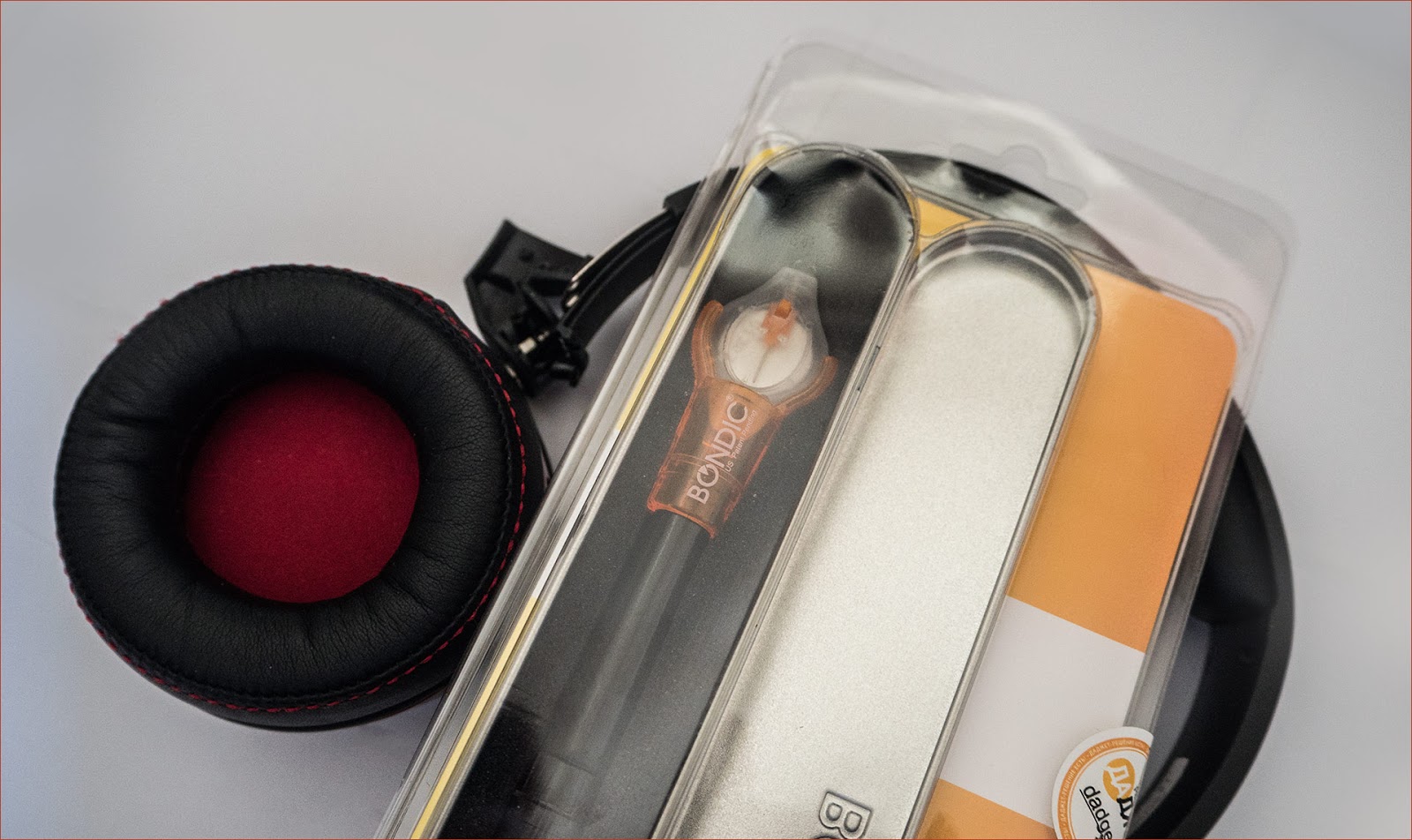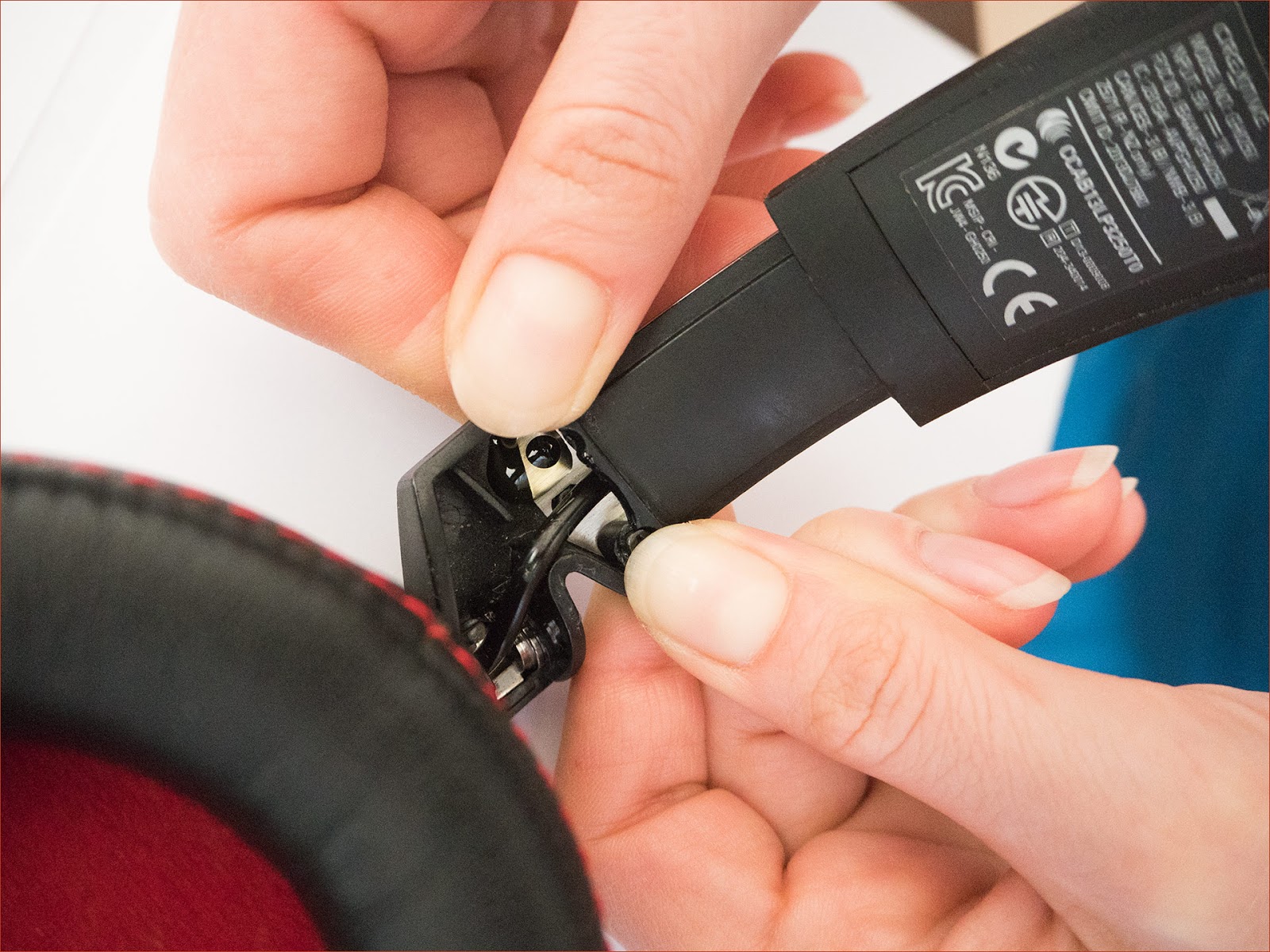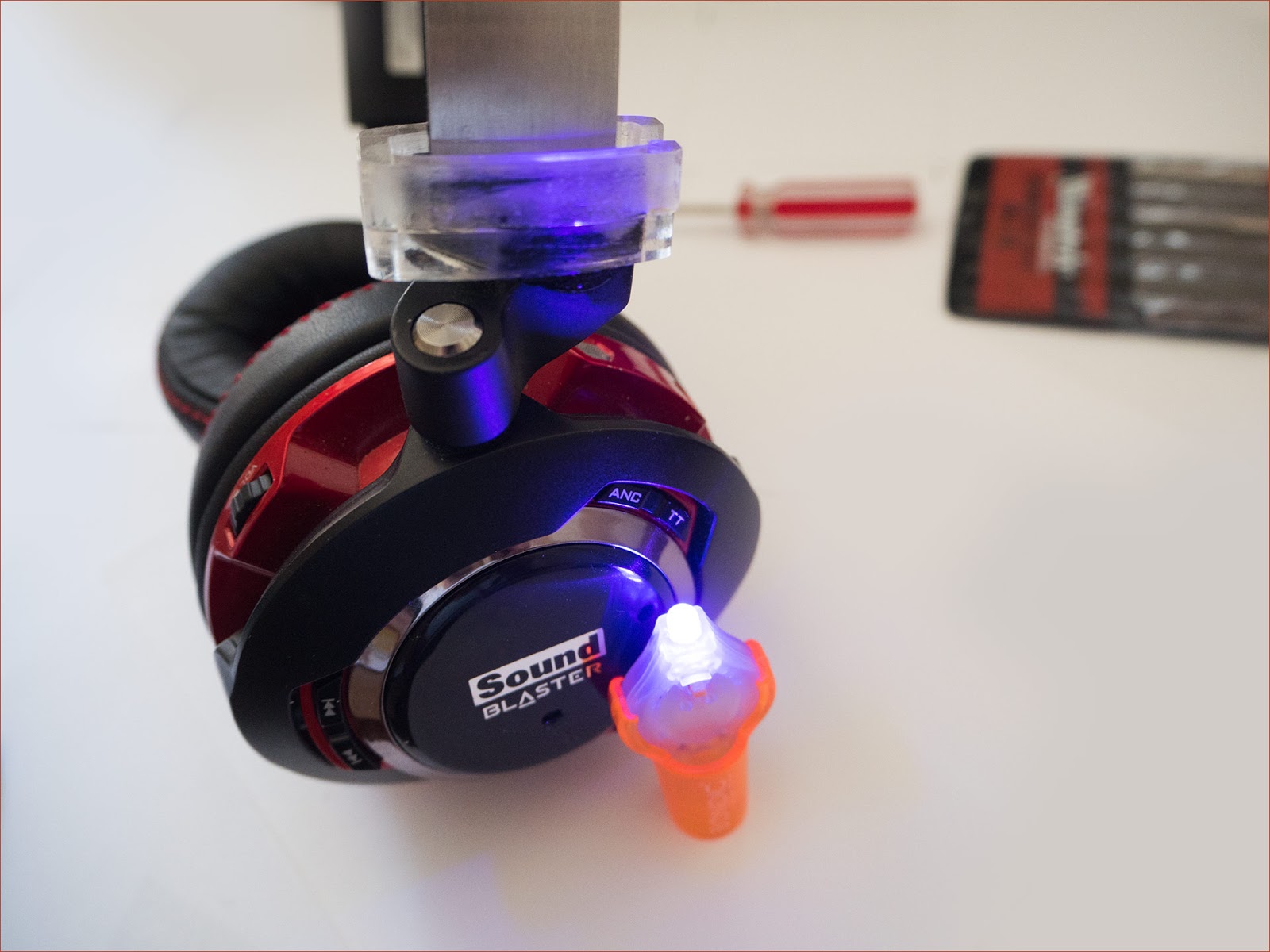Bondic Light Cured Plastic
In the age of winning marketing, the planned obsolescence, unfortunately, no one is surprised. Flimsy plastic, inept pairing of carriers, one-piece connections ... everything is good if the user has to buy a new gadget.

Well, if the device can be repaired on its own, and the failure is not in the field of electronics: a plastic part can at least be restored: adhesives, epoxy resins and 3D printers will help, if that. In the extreme case, there is an invincible combination of superglue and baking soda, which is not very convenient in work, but effective. A high-tech alternative to this compound is light - cured plastic . Quick, clean and easy to control. We will check on a broken headset SB Evo ZXR.
As usual, the place of articulation of the headband with the speaker cups broke. This tilt-and-slide gizmo is rarely done reliably, but the creators of the ZXR went even further: it seemed to be specially created flawed. Look at how deep the metal edges go into the plastic!
')

All that kept them - three modest screws, having no nut at the end - only plastic tides with a frail thread. But the load on this element of the go-go: here and the head is bursting with a metal spring, and she resists, and the cups themselves have two degrees of freedom, and hold, in fact, on this pathetic piece of plastic. Even with the most accurate use, it is difficult to avoid breakdowns in such a poor design.

It is good if it just cracked and broke, as on the left side: on the right, a piece of the construction just fell out during operation and was lost, and then the last screw gave up. I didn’t want to bother with “dirty” technology (a bunch of superglue + soda as a hardener-filler): I did everything neatly, without killing and without bruising the wire, it was hard, and I, frankly, hope that I can redo these poor details on 3D printer entirely.
The basis of the work of this thing is the photopolymerization effect. The substance in the normal state is a monomer, at room temperature in the liquid phase. Absorption of photons with a certain energy (that is, light with a certain wavelength) leads to the rupture of one of the double bonds in the molecules: half remains to keep the “old” part, the second stretches to the next. In this case, the UV radiation acts only as the initiator of the reaction and accelerates the hardening: you can shine a small drop on a small volume in just a second, and it slowly hardens before your eyes. If you continue to “feed” the reaction, the polymerization will simply pass faster.

According to the instructions, the surfaces need to be cleaned, degreased and dried: since we do not have a solvent in the kit, which will melt the “old” material into the new structure, the coupling of the two materials will be quite limited: what will be the “rough” surface to be glued (restored) - all the better.

Nail polish remover + file has done its job: the plastic is scratched and dimmed enough, you can apply the composition. Combine the steel plate with the old screw holes, expose the parts at the right angle and begin to fill the holes with the original substance.

4 seconds of ultraviolet - a drop turned into a slightly hazy and yellowish plastic. Add another layer, form stiffeners, continue to “cast” the part, gradually hardening the finished elements.

As a final touch - external amplifiers, cut from Plexiglas exactly the shape of the old parts. UV-transparent plastic (checked with a drop of polymer between the two parts), so that problems with curing and the formation of a single part should not be.

We apply a thin layer on the surfaces to be glued together (after degreasing them, of course), we string the self-made “non-removable formwork” and apply photopolymerization magic. Wait a bit, test for strength, and can be processed for further use: sanding, priming and painting new elements of construction in black.

Working with this thing is much more pleasant than with super glue, epoxy, or something else. The main difference is visibility and the ability to fully control the process. The pen-container and the unit with a flashlight are separated, and even a very difficult part can be restored in a narrow place: at least a couple of drops harden and build up the necessary elements, no one breathes in the back, the solution does not tend to harden itself in a short period of time and does not dissolve bonded surfaces. In terms of comfort - a definite credit.
Disadvantages are also found, where do without them. Firstly, it is NOT GLUE: it does not merge into the molecular structure and does not “melt” plastic before bonding. Secondly, to completely glue the surfaces completely closed from the review will be released only if one of them is transparent to UV radiation. And thirdly - volumes. In a tube out of the box, only 10 ml of the substance is not to say that there is not enough of it, but it will not be possible to perform large-volume casting. Additional containers for the same 10 milliliters are sold, but the price of a major repair is unlikely to please you: it’s easier to use a light-cured polymer as the first stage of repair: fix the parts, protect the same electronics with a “wall” from the edge of the break, make a “channel” for the cable, and the rest should be poured with classics with two-component resins or the same superglue with soda. The work will be done much more carefully, and you will not have to hurry - you will fix the most difficult and narrow places with “Bondik”, and you will complete the supporting structure from difficult to handle, but more accessible materials.
In sum, we have such a magic wand that you can always have on hand: fix the mount, fix the broken case, quickly restore the torn landing pads for the screws. Not a panacea, but in a difficult moment it will help out, and the price for such a “marching” option is quite reasonable. GT-IT is a 10% bonus for blog readers.
Author: Ivan Krylov, Moscow

Well, if the device can be repaired on its own, and the failure is not in the field of electronics: a plastic part can at least be restored: adhesives, epoxy resins and 3D printers will help, if that. In the extreme case, there is an invincible combination of superglue and baking soda, which is not very convenient in work, but effective. A high-tech alternative to this compound is light - cured plastic . Quick, clean and easy to control. We will check on a broken headset SB Evo ZXR.
Break point cannot be changed
As usual, the place of articulation of the headband with the speaker cups broke. This tilt-and-slide gizmo is rarely done reliably, but the creators of the ZXR went even further: it seemed to be specially created flawed. Look at how deep the metal edges go into the plastic!
')

All that kept them - three modest screws, having no nut at the end - only plastic tides with a frail thread. But the load on this element of the go-go: here and the head is bursting with a metal spring, and she resists, and the cups themselves have two degrees of freedom, and hold, in fact, on this pathetic piece of plastic. Even with the most accurate use, it is difficult to avoid breakdowns in such a poor design.

It is good if it just cracked and broke, as on the left side: on the right, a piece of the construction just fell out during operation and was lost, and then the last screw gave up. I didn’t want to bother with “dirty” technology (a bunch of superglue + soda as a hardener-filler): I did everything neatly, without killing and without bruising the wire, it was hard, and I, frankly, hope that I can redo these poor details on 3D printer entirely.
Bondic - light-cured plastic
The basis of the work of this thing is the photopolymerization effect. The substance in the normal state is a monomer, at room temperature in the liquid phase. Absorption of photons with a certain energy (that is, light with a certain wavelength) leads to the rupture of one of the double bonds in the molecules: half remains to keep the “old” part, the second stretches to the next. In this case, the UV radiation acts only as the initiator of the reaction and accelerates the hardening: you can shine a small drop on a small volume in just a second, and it slowly hardens before your eyes. If you continue to “feed” the reaction, the polymerization will simply pass faster.

Practical use
According to the instructions, the surfaces need to be cleaned, degreased and dried: since we do not have a solvent in the kit, which will melt the “old” material into the new structure, the coupling of the two materials will be quite limited: what will be the “rough” surface to be glued (restored) - all the better.

Nail polish remover + file has done its job: the plastic is scratched and dimmed enough, you can apply the composition. Combine the steel plate with the old screw holes, expose the parts at the right angle and begin to fill the holes with the original substance.

4 seconds of ultraviolet - a drop turned into a slightly hazy and yellowish plastic. Add another layer, form stiffeners, continue to “cast” the part, gradually hardening the finished elements.

As a final touch - external amplifiers, cut from Plexiglas exactly the shape of the old parts. UV-transparent plastic (checked with a drop of polymer between the two parts), so that problems with curing and the formation of a single part should not be.

We apply a thin layer on the surfaces to be glued together (after degreasing them, of course), we string the self-made “non-removable formwork” and apply photopolymerization magic. Wait a bit, test for strength, and can be processed for further use: sanding, priming and painting new elements of construction in black.

Impressions and conclusions
Working with this thing is much more pleasant than with super glue, epoxy, or something else. The main difference is visibility and the ability to fully control the process. The pen-container and the unit with a flashlight are separated, and even a very difficult part can be restored in a narrow place: at least a couple of drops harden and build up the necessary elements, no one breathes in the back, the solution does not tend to harden itself in a short period of time and does not dissolve bonded surfaces. In terms of comfort - a definite credit.
Disadvantages are also found, where do without them. Firstly, it is NOT GLUE: it does not merge into the molecular structure and does not “melt” plastic before bonding. Secondly, to completely glue the surfaces completely closed from the review will be released only if one of them is transparent to UV radiation. And thirdly - volumes. In a tube out of the box, only 10 ml of the substance is not to say that there is not enough of it, but it will not be possible to perform large-volume casting. Additional containers for the same 10 milliliters are sold, but the price of a major repair is unlikely to please you: it’s easier to use a light-cured polymer as the first stage of repair: fix the parts, protect the same electronics with a “wall” from the edge of the break, make a “channel” for the cable, and the rest should be poured with classics with two-component resins or the same superglue with soda. The work will be done much more carefully, and you will not have to hurry - you will fix the most difficult and narrow places with “Bondik”, and you will complete the supporting structure from difficult to handle, but more accessible materials.
In sum, we have such a magic wand that you can always have on hand: fix the mount, fix the broken case, quickly restore the torn landing pads for the screws. Not a panacea, but in a difficult moment it will help out, and the price for such a “marching” option is quite reasonable. GT-IT is a 10% bonus for blog readers.
Author: Ivan Krylov, Moscow
Source: https://habr.com/ru/post/373665/
All Articles